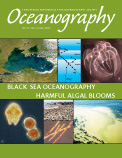First Paragraph
Nitrogen is an essential nutrient for living systems in the ocean; it is a component of proteins, chlorophyll, and nucleic acids. In the oceans, nitrogen exists as a dissolved gas (N2), dissolved organic matter, or as the dissolved inorganic ions nitrate (NO3–), nitrite (NO2–), and ammonium (NH4+). Nitrogen has a relatively short lifetime in the ocean and we are still striving to understand its sources and sinks. Transformations under oxygen-limited conditions are some of its main sinks. The Black Sea is an ideal location to study nitrogen reactions that occur under low-oxygen conditions because it has a well-defined low-oxygen, or suboxic, zone at the boundary between its oxic surface layer and sulfidic (anoxic) deep water.

